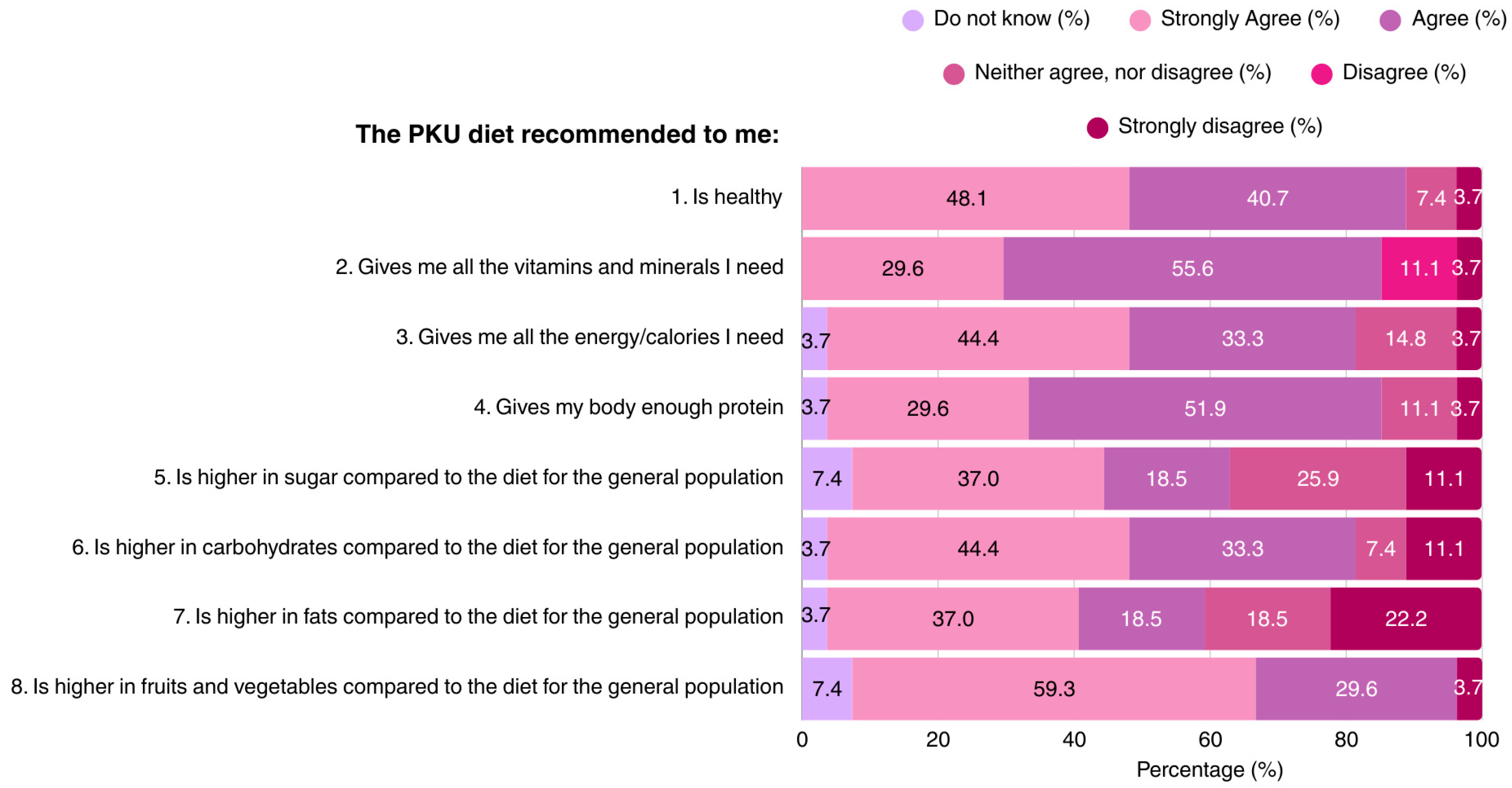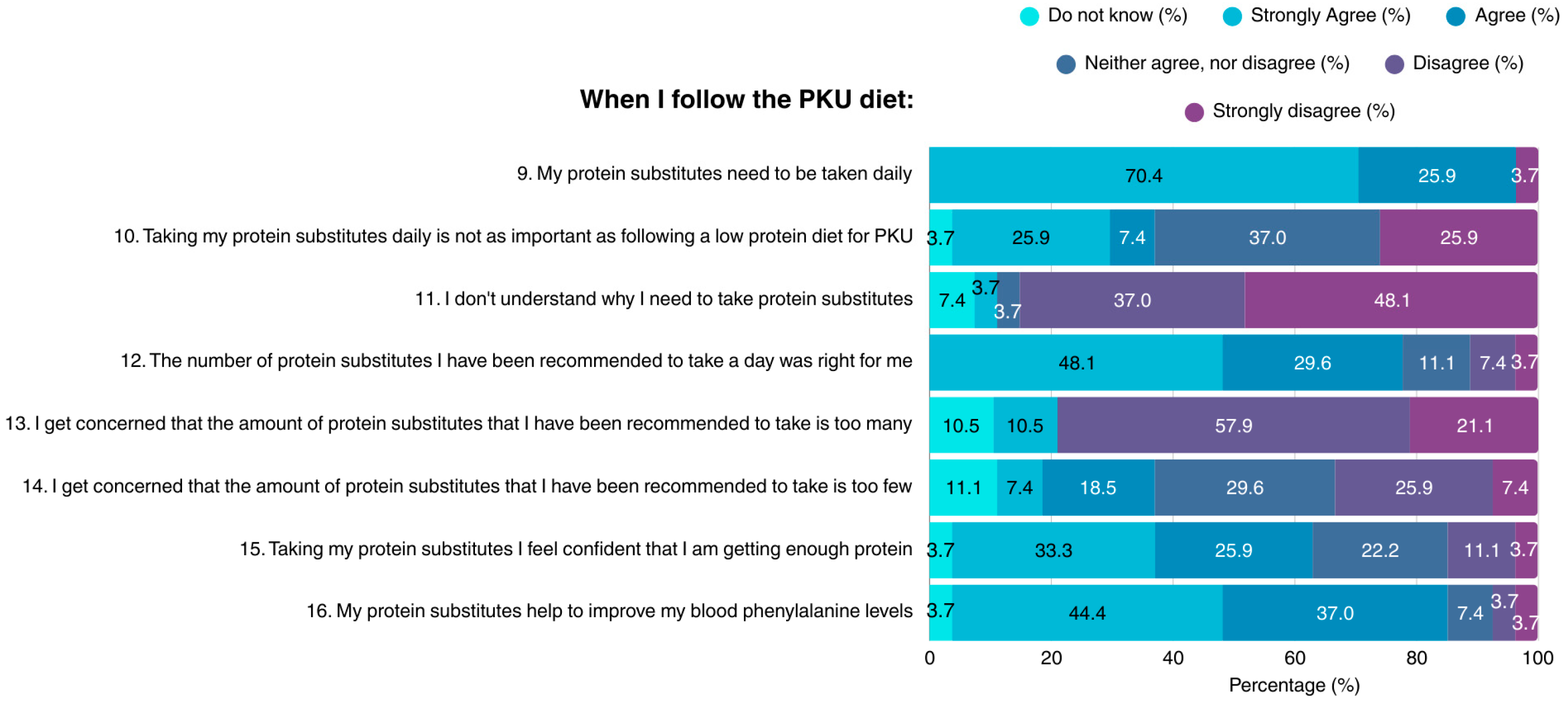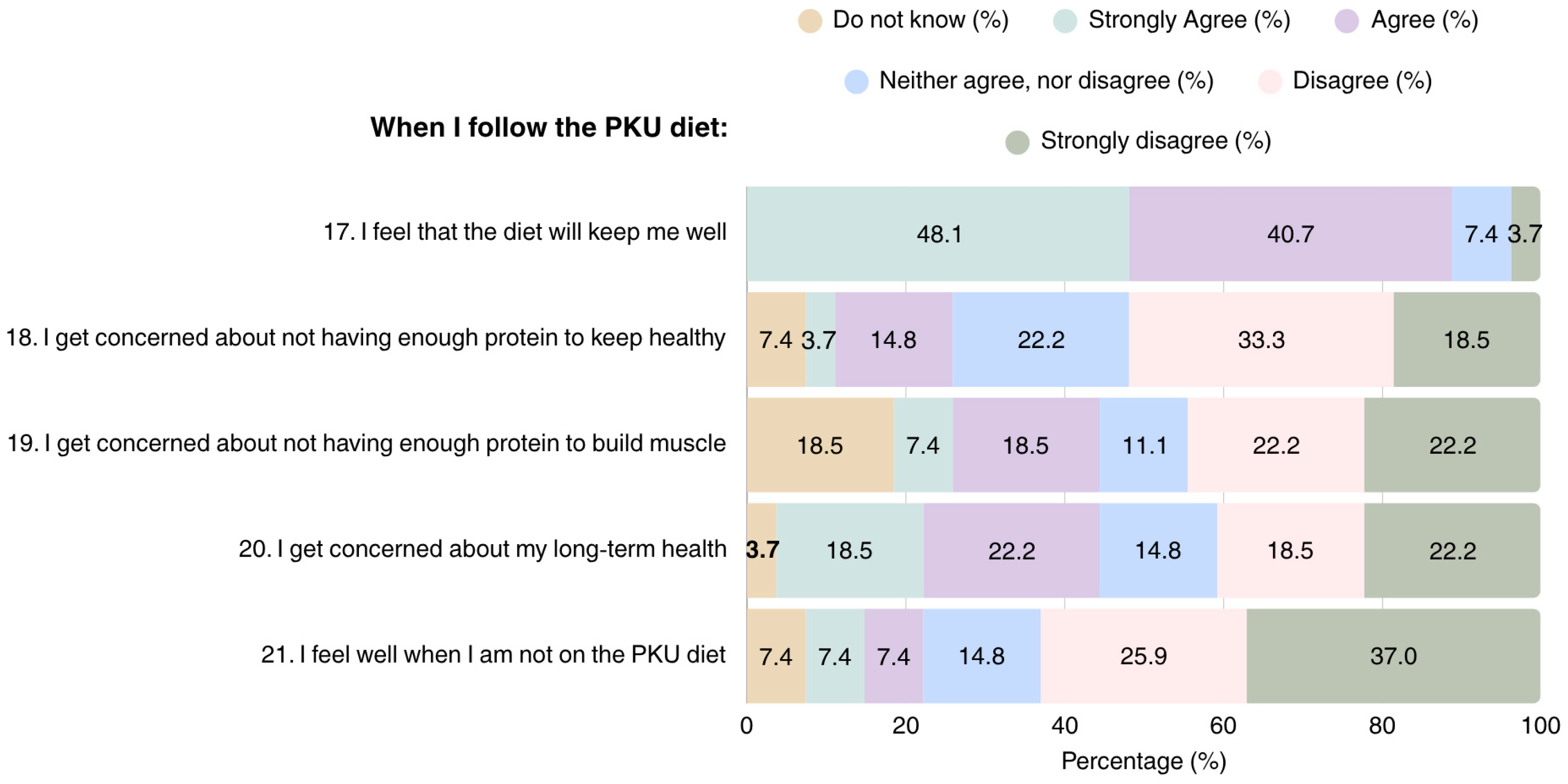Nutritional Practices and Knowledge of Patients with Phenylketonuria
Abstract
1. Introduction
2. Materials and Methods
2.1. Sample Recruitment
2.2. Questionnaires
2.3. Statistical Analyses
3. Results
3.1. Dietary Behaviors
3.2. Perceptions Regarding the PKU Diet
4. Discussion
Study Strengths and Limitations
5. Conclusions
Author Contributions
Funding
Institutional Review Board Statement
Informed Consent Statement
Data Availability Statement
Conflicts of Interest
Abbreviations
| cGMP | Glycomacropeptide |
| IEM | Inborn Error of Metabolism |
| LNAAs | Large neutral amino acids |
| MNT | Medical nutrition therapy |
| Phe | Phenylalanine |
| PAL | Phenylalanine ammonia lyase |
| PAH | Phenylalanine hydroxylase |
| PKU | Phenylketonuria |
| BH4 | Tetrahydrobiopterin |
| Tyr | Tyrosine |
References
- van Spronsen, F.J.; Blau, N.; Harding, C.; Burlina, A.; Longo, N.; Bosch, A.M. Phenylketonuria. Nat. Rev. Dis. Prim. 2021, 7, 36. [Google Scholar] [CrossRef]
- Hillert, A.; Anikster, Y.; Belanger-Quintana, A.; Burlina, A.; Burton, B.K.; Carducci, C.; Chiesa, A.E.; Christodoulou, J.; Đorđević, M.; Desviat, L.R.; et al. The Genetic Landscape and Epidemiology of Phenylketonuria. Am. J. Hum. Genet. 2020, 107, 234–250. [Google Scholar] [CrossRef]
- Hata, I.; Yuasa, M.; Isozaki, Y. Phenylketonuria. In Human Pathobiochemistry: From Clinical Studies to Molecular Mechanisms; StatPearls Publishing: Treasure Island, FL, USA, 2023; pp. 101–110. ISBN 9789811329777. [Google Scholar]
- Talebi, S.; Eshraghi, P. Nutrition in Phenylketonuria. Clin. Nutr. ESPEN 2024, 64, 307–313. [Google Scholar] [CrossRef]
- Hydery, T.; Coppenrath, V.A. A Comprehensive Review of Pegvaliase, an Enzyme Substitution Therapy for the Treatment of Phenylketonuria. Drug Target Insights 2019, 13, 1177392819857089. [Google Scholar] [CrossRef]
- Sara, G.-L.; Alejandra, L.-M.L.; Isabel, I.-G.; Marcela, V.-A. Conventional Phenylketonuria Treatment. J. Inborn Errors Metab. Screen. 2016, 4, 232640981668573. [Google Scholar] [CrossRef]
- Rondanelli, M.; Porta, F.; Gasparri, C.; Barrile, G.C.; Cavioni, A.; Mansueto, F.; Mazzola, G.; Patelli, Z.; Peroni, G.; Pirola, M.; et al. A Food Pyramid for Adult Patients with Phenylketonuria and a Systematic Review on the Current Evidences Regarding the Optimal Dietary Treatment of Adult Patients with PKU. Clin. Nutr. 2023, 42, 732–763. [Google Scholar] [CrossRef] [PubMed]
- Macdonald, A.; Daly, A.; Davies, P.; Asplin, D.; Hall, S.K.; Rylance, G.; Chakrapani, A. Protein Substitutes for PKU: What’s New? J. Inherit. Metab. Dis. 2004, 27, 363–371. [Google Scholar] [CrossRef] [PubMed]
- Vieira, T.A.; Nalin, T.; Krug, B.C.; Bittar, C.M.; Netto, C.B.O.; Schwartz, I.V.D. Adherence to Treatment of Phenylketonuria. J. Inborn Errors Metab. Screen. 2015, 3, 232640981557986. [Google Scholar] [CrossRef]
- Firman, S.J.; Ramachandran, R.; Whelan, K. Knowledge, Perceptions and Behaviours Regarding Dietary Management of Adults Living with Phenylketonuria. J. Hum. Nutr. Diet. 2022, 35, 1016–1029. [Google Scholar] [CrossRef]
- Vieira Neto, E.; Maia Filho, H.S.; Monteiro, C.B.; Carvalho, L.M.; Tonon, T.; Vanz, A.P.; Schwartz, I.V.D.; Ribeiro, M.G. Quality of Life and Adherence to Treatment in Early-Treated Brazilian Phenylketonuria Pediatric Patients. Braz. J. Med. Biol. Res. 2018, 51, e6709. [Google Scholar] [CrossRef]
- Teruya, K.I.; Remor, E.; Schwartz, I.V.D. Factors That Increase Risk for Poor Adherence to Phenylketonuria Treatment in Brazilian Patients. Am. J. Med. Genet. Part A 2021, 185, 1991–2002. [Google Scholar] [CrossRef]
- Green, B.; Browne, R.; Firman, S.; Hill, M.; Rahman, Y.; Kaalund Hansen, K.; Adam, S.; Skeath, R.; Hallam, P.; Herlihy, I.; et al. Nutritional and Metabolic Characteristics of UK Adult Phenylketonuria Patients with Varying Dietary Adherence. Nutrients 2019, 11, 2459. [Google Scholar] [CrossRef]
- Ilgaz, F.; Ford, S.; O’Driscoll, M.F.; MacDonald, A. Adult PKU Clinics in the UK-Users’ Experiences and Perspectives. Nutrients 2023, 15, 4352. [Google Scholar] [CrossRef] [PubMed]
- Mezzomo, T.R.; Dias, M.R.M.G.; Santos, T.; Pereira, R.M. Dietary Intake in Individuals with Phenylketonuria: An Integrative Review. Nutr. Hosp. 2024, 41, 212–223. [Google Scholar] [CrossRef] [PubMed]
- Witalis, E.; Mikoluc, B.; Motkowski, R.; Sawicka-Powierza, J.; Chrobot, A.; Didycz, B.; Lange, A.; Mozrzymas, R.; Milanowski, A.; Nowacka, M.; et al. Phenylketonuria Patients’ and Their Parents’ Knowledge and Attitudes to the Daily Diet—Multi-Centre Study. Nutr. Metab. 2017, 14, 57. [Google Scholar] [CrossRef] [PubMed]
- Venegas, E.; Langeveld, S.; Ahring, K.; Benitez, R.; Desloovere, A.; Dios, E.; Gómez, E.; Hermida, A.; Marsaux, C.; Verloo, P.; et al. Nutrient Status and Intakes of Adults with Phenylketonuria. Nutrients 2024, 16, 2724. [Google Scholar] [CrossRef]
- Bekhof, J.; van Spronsen, F.J.; Crone, M.R.; van Rijn, M.; Oudshoorn, C.G.M.; Verkerk, P.H. Influence of Knowledge of the Disease on Metabolic Control in Phenylketonuria. Eur. J. Pediatr. 2003, 162, 440–442. [Google Scholar] [CrossRef]
- Brumm, V.L.; Bilder, D.; Waisbren, S.E. Psychiatric Symptoms and Disorders in Phenylketonuria. Mol. Genet. Metab. 2010, 99 (Suppl. 1), S59–S63. [Google Scholar] [CrossRef]
- Cazzorla, C.; Bensi, G.; Biasucci, G.; Leuzzi, V.; Manti, F.; Musumeci, A.; Papadia, F.; Stoppioni, V.; Tummolo, A.; Vendemiale, M.; et al. Living with Phenylketonuria in Adulthood: The PKU ATTITUDE Study. Mol. Genet. Metab. Rep. 2018, 16, 39–45. [Google Scholar] [CrossRef]
- van Spronsen, F.J.; van Wegberg, A.M.; Ahring, K.; Bélanger-Quintana, A.; Blau, N.; Bosch, A.M.; Burlina, A.; Campistol, J.; Feillet, F.; Giżewska, M.; et al. Key European Guidelines for the Diagnosis and Management of Patients with Phenylketonuria. Lancet Diabetes Endocrinol. 2017, 5, 743–756. [Google Scholar] [CrossRef]
- Ahring, K.; Bélanger-Quintana, A.; Dokoupil, K.; Gokmen-Ozel, H.; Lammardo, A.M.; MacDonald, A.; Motzfeldt, K.; Nowacka, M.; Robert, M.; van Rijn, M. Blood Phenylalanine Control in Phenylketonuria: A Survey of 10 European Centres. Eur. J. Clin. Nutr. 2011, 65, 275–278. [Google Scholar] [CrossRef]
- Beazer, J.; Breck, J.; Eggerding, C.; Gordon, P.; Hacker, S.; Thompson, A. Strategies to Engage Lost to Follow-up Patients with Phenylketonuria in the United States: Best Practice Recommendations. Mol. Genet. Metab. Reports 2020, 23, 100571. [Google Scholar] [CrossRef] [PubMed]
- Anjema, K.; van Rijn, M.; Verkerk, P.H.; Burgerhof, J.G.M.; Heiner-Fokkema, M.R.; van Spronsen, F.J. PKU: High Plasma Phenylalanine Concentrations Are Associated with Increased Prevalence of Mood Swings. Mol. Genet. Metab. 2011, 104, 231–234. [Google Scholar] [CrossRef]
- Klimek, A.; Baerwald, C.; Schwarz, M.; Rutsch, F.; Parhofer, K.G.; Plöckinger, U.; Heddrich-Ellerbrok, M.; Vom Dahl, S.; Schöne, K.; Ott, M.; et al. Everyday Life, Dietary Practices, and Health Conditions of Adult PKU Patients: A Multicenter, Cross-Sectional Study. Ann. Nutr. Metab. 2020, 76, 251–258. [Google Scholar] [CrossRef]
- Reach, G. Phenylketonuria as an Adherence Disease. Patient Prefer. Adherence 2025, 19, 1059–1073. [Google Scholar] [CrossRef]
- Yagudina, R.; Kulikov, A.; Serpik, V.; Protsenko, M.; Kopeyka, K. Factors Affecting Adherence to a Low Phenylalanine Diet in Patients with Phenylketonuria: A Systematic Review. Nutrients 2024, 16, 3119. [Google Scholar] [CrossRef]
- Di Ciommo, V.; Forcella, E.; Cotugno, G. Living with Phenylketonuria from the Point of View of Children, Adolescents, and Young Adults: A Qualitative Study. J. Dev. Behav. Pediatr. 2012, 33, 229–235. [Google Scholar] [CrossRef]
- Sharman, R.; Mulgrew, K.; Katsikitis, M. Qualitative Analysis of Factors Affecting Adherence to the Phenylketonuria Diet in Adolescents. Clin. Nurse Spec. 2013, 27, 205–210. [Google Scholar] [CrossRef]
- González-Lamuño, D.; Morencos, C.; Arrieta, F.J.; Venegas, E.; Vicente-Rodríguez, G.; Casajús, J.A.; Couce, M.L.; Aldámiz-Echevarría, L. Supplementation for Performance and Health in Patients with Phenylketonuria: An Exercise-Based Approach to Improving Dietary Adherence. Nutrients 2024, 16, 639. [Google Scholar] [CrossRef] [PubMed]
- Tummolo, A.; Carella, R.; Carone, P.; Paterno, G.; De Giovanni, D. Intake Modalities of Amino Acid Supplements: A Real-World Data Collection from Phenylketonuria Patients. Nutrients 2024, 16, 669. [Google Scholar] [CrossRef] [PubMed]
- Pinto, A.; Ilgaz, F.; Evans, S.; van Dam, E.; Rocha, J.C.; Karabulut, E.; Hickson, M.; Daly, A.; MacDonald, A. Phenylalanine Tolerance over Time in Phenylketonuria: A Systematic Review and Meta-Analysis. Nutrients 2023, 15, 3506. [Google Scholar] [CrossRef] [PubMed]
- Moretti, F.; Pellegrini, N.; Salvatici, E.; Rovelli, V.; Banderali, G.; Radaelli, G.; Scazzina, F.; Giovannini, M.; Verduci, E. Dietary Glycemic Index, Glycemic Load and Metabolic Profile in Children with Phenylketonuria. Nutr. Metab. Cardiovasc. Dis. 2017, 27, 176–182. [Google Scholar] [CrossRef] [PubMed]
- Couce, M.L.; Sánchez-Pintos, P.; Vitoria, I.; De Castro, M.-J.; Aldámiz-Echevarría, L.; Correcher, P.; Fernández-Marmiesse, A.; Roca, I.; Hermida, A.; Martínez-Olmos, M.; et al. Carbohydrate Status in Patients with Phenylketonuria. Orphanet J. Rare Dis. 2018, 13, 103. [Google Scholar] [CrossRef]
- Özen Yeşil, B.; Koç, N.; Köseler Beyaz, E.; Kucukcongar, A.; Bilginer Gürbüz, B.; Kasapkara, Ç.S. Evaluation of the Effect of Diet Adherence on Nutritional Status and Metabolic Control in Children with Phenylketonuria Consuming a Phenylalanine-Restricted Diet: A Single-Center Study. Turkish J. Pediatr. Dis. 2025, 19, 64–70. [Google Scholar] [CrossRef]
- Durham-Shearer, S.J.; Judd, P.A.; Whelan, K.; Thomas, J.E. Knowledge, Compliance and Serum Phenylalanine Concentrations in Adolescents and Adults with Phenylketonuria and the Effect of a Patient-Focused Educational Resource. J. Hum. Nutr. Diet. 2008, 21, 474–485. [Google Scholar] [CrossRef] [PubMed]




| Women/men (n, %) | 19 (70.4%)/8 (29.6%) |
| Age (years) | 31.85 ± 11.2 |
| Body weight (kg) | 76.1 ± 19.4 |
| Stature (cm) | 166.3 ± 10.2 |
| BMI (kg/m2) | 26.2 ± 7.6 |
| Weight status (normoweight/overweight/obesity) (n) | 13/6/8 |
| Marital status (single/divorced/married/other) (n) | 16/1/8/2 |
| Higher education attained (secondary/tertiary/post-graduate) (n) | 9/9/9 |
| Question | Answers (% of Positive Answers) |
|---|---|
| 1. PKU diet pattern | (a) Always on a diet (66.7%) |
| (b) Return to diet on occasions (29.6%) | |
| (c) Off diet (3.7%) | |
| 2. Number of PKU exchanges recommended each day | (a) ≤5 (7.4%) |
| (b) >5–10 (25.9%) | |
| (c) >10–15 (11.1%) | |
| (d) >15–20 (14.8%) | |
| (e) >20 (3.7%) | |
| (f) Do not know (37%) | |
| 3. Number of PKU exchanges consumed each day | (a) ≤5 (7.4%) |
| (b) >5–10 (14.8%) | |
| (c) >10–15 (22.2%) | |
| (d) >15–20 (7.4%) | |
| (e) >20 (7.4%) | |
| (f) Do not know (40.7%) | |
| 4. Frequency of protein substitute advised per day | (a) Once/daily (3.7%) |
| (b) Twice/daily (11.1%) | |
| (c) Thrice/daily (66.7%) | |
| (d) ≥4 times/daily (7.4%) | |
| (e) Do not know (7.4%) | |
| (f) Other (3.7%) | |
| 5. Frequency of protein substitute taken per day | (a) Once/daily (7.4%) |
| (b) Twice/daily (18.5%) | |
| (c) Thrice/daily (55.6%) | |
| (d) ≥4 times/daily (3.7%) | |
| (e) Do not know (7.4%) | |
| (f) Other (7.4%) | |
| 6. Daily protein substitute taken vs. advised | (a) less than recommended (29.6%) |
| (b) as recommended (66.7%) | |
| (c) more than recommended (3.7%) | |
| 7. Frequency of missing some/all protein substitute | (a) Every day (11.1%) |
| (b) 2–4 times per week (14.8%) | |
| (c) Once weekly (14.8%) | |
| (d) Once a fortnight (7.4%) | |
| (e) Less than once a fortnight (11.1%) | |
| (f) I never miss taking my protein substitute (40.7%) | |
| 8. Blood Phe target level advised | (a) Less than 300 μmol L−1 (7.4%) |
| (b) Between 120–360 μmol L−1 (18.5%) | |
| (c) Between 120–600 μmol L−1 (29.6%) | |
| (d) Less than 700 μmol L−1 (18.5%) | |
| (e) Less than 1000 μmol L−1 (7.4%) | |
| (f) I do not have a Phe target (11.1%) | |
| (g) I do not know (7.4%) | |
| 9. Last reported blood Phe concentrations | (a) Phe ≤ 600 μmol L−1 (14.8%) |
| (b) Phe < 120 μmol L−1 (7.4%) | |
| (c) Phe between 120–360 μmol L−1 (11.1%) | |
| (d) Phe between 360–600 μmol L−1 (14.8%) | |
| (e) Phe > 600 μmol L−1 (3.7%) | |
| (f) Phe between 600–1000 μmol L−1 (22.2%) | |
| (g) Phe > 1000 μmol L−1 (0.0%) | |
| (h) I do not know (25.9%) |
Disclaimer/Publisher’s Note: The statements, opinions and data contained in all publications are solely those of the individual author(s) and contributor(s) and not of MDPI and/or the editor(s). MDPI and/or the editor(s) disclaim responsibility for any injury to people or property resulting from any ideas, methods, instructions or products referred to in the content. |
© 2025 by the authors. Licensee MDPI, Basel, Switzerland. This article is an open access article distributed under the terms and conditions of the Creative Commons Attribution (CC BY) license (https://creativecommons.org/licenses/by/4.0/).
Share and Cite
Kaloteraki, E.; Pardali, E.C.; Poulimeneas, D.; Mylona, V.; Fotiadou, E.; Papa, K.; Gioxari, A.; Spilioti, M.; Bogdanos, D.P.; Grammatikopoulou, M.G. Nutritional Practices and Knowledge of Patients with Phenylketonuria. Nutrients 2025, 17, 3351. https://doi.org/10.3390/nu17213351
Kaloteraki E, Pardali EC, Poulimeneas D, Mylona V, Fotiadou E, Papa K, Gioxari A, Spilioti M, Bogdanos DP, Grammatikopoulou MG. Nutritional Practices and Knowledge of Patients with Phenylketonuria. Nutrients. 2025; 17(21):3351. https://doi.org/10.3390/nu17213351
Chicago/Turabian StyleKaloteraki, Eirini, Eleni C. Pardali, Dimitrios Poulimeneas, Varvara Mylona, Eleni Fotiadou, Kyriaki Papa, Aristea Gioxari, Martha Spilioti, Dimitrios P. Bogdanos, and Maria G. Grammatikopoulou. 2025. "Nutritional Practices and Knowledge of Patients with Phenylketonuria" Nutrients 17, no. 21: 3351. https://doi.org/10.3390/nu17213351
APA StyleKaloteraki, E., Pardali, E. C., Poulimeneas, D., Mylona, V., Fotiadou, E., Papa, K., Gioxari, A., Spilioti, M., Bogdanos, D. P., & Grammatikopoulou, M. G. (2025). Nutritional Practices and Knowledge of Patients with Phenylketonuria. Nutrients, 17(21), 3351. https://doi.org/10.3390/nu17213351







